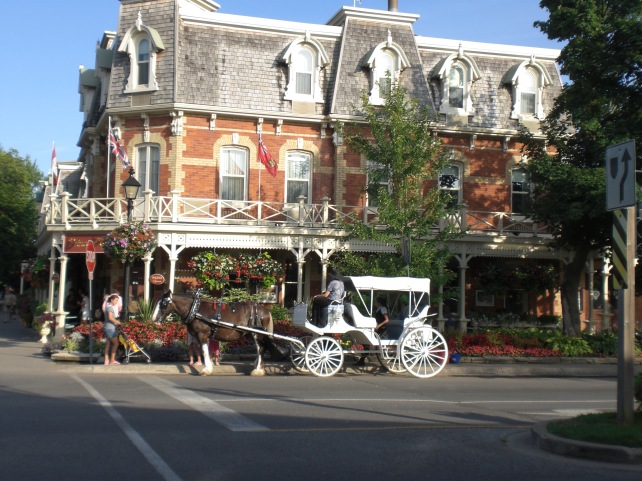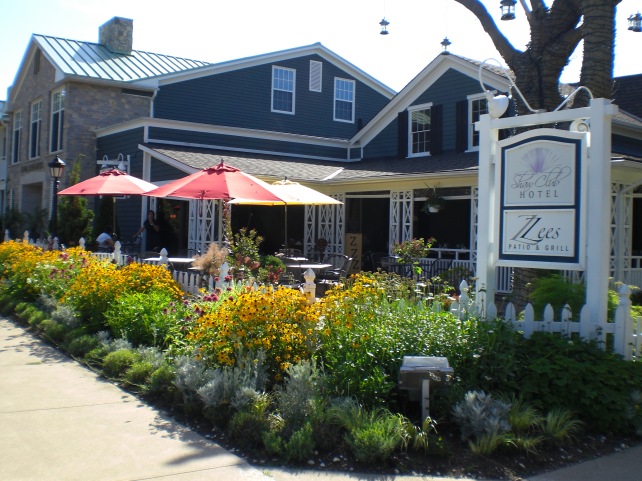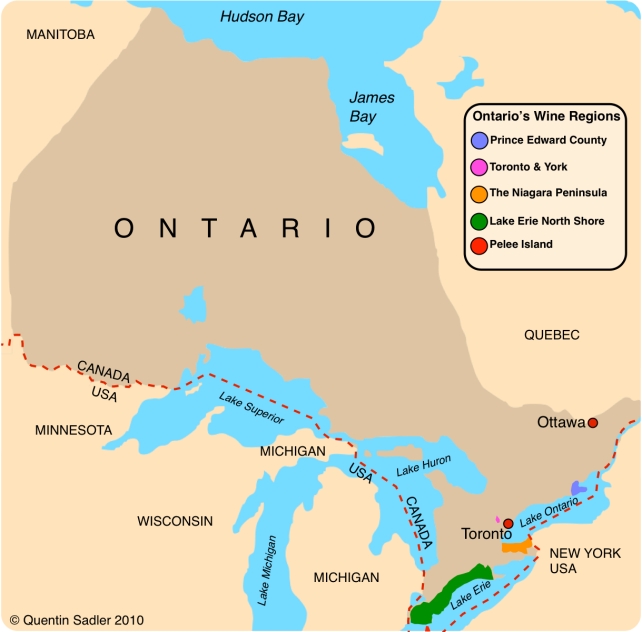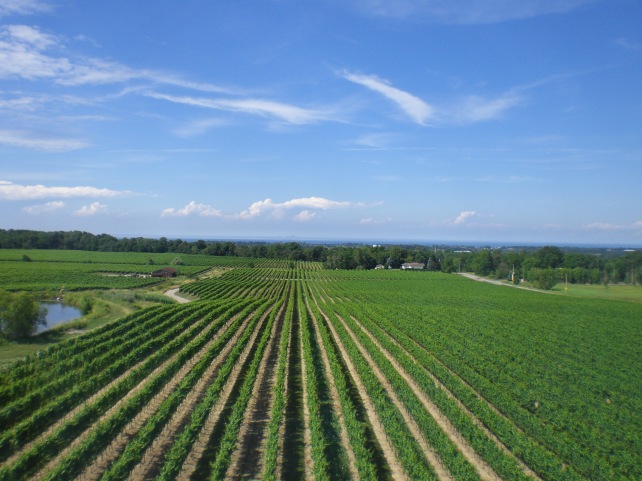Many things about my trip to New York State and Canada surprised me, not least the fact that there is a vibrant wine culture in this seemingly unlikey part of the world.
I used to always imagine that if you traced a line from Toronto, say, to Europe you would arrive at Bergen or Aberdeen – actually it’s Tuscany. Tuscany with extreme winters though. It is the winters that have traditionally prevented this part of the world from being seen as a leading wine region.
The New York part of the trip was wonderful, I learned and experienced a great deal, but the Canadian leg of the journey was in no way an anticlimax.
Firstly the journey over the Rainbow Bridge at Niagara Falls was terribly exciting and then Niagara-on-the Lake was simply one of the prettiest towns I have ever visited – indeed it was quite like Stellenbosch in many ways, twee and touristy, but so nicely done. Staying in a wonderful hotel like the Shaw Club was a real treat. It was a great place to stay and if you are feeling lonely they will even lend you a fish for company!
My experience of Canadian wine was pretty slim up until that point, so three days touring the Niagara Peninsula wineries was a great opportunity to expand my knowledge.
The history of grape growing and wine making, as far as I can tell, is rather similar to over the border in New York. Wines have been made here for more than 200 years from hardy native grape varieties, but finer vitis vinifera grapes found it hard to survive in this difficult climate with its extreme winters.
Cold conditions also bite in the spring and autumn, thus limiting the growing season. Ontario is the most southerly part of the country, so has the best chance to make wine, added to which the Great Lakes are the largest freshwater system in the world and, like a sea, have a moderating effect on the extreme temperatures.
So, originally native grapes like Concord were used followed by hardy hybrids like Niagara and Maréchal Foch, which are crosses of native grapes and vitis vinifera. Everything changed in 1975, however, when Karl Kaiser and Donald Ziraldo, who had both been brought up drinking European wine, realised that quality wine that they wanted to drink could only be made from vitis vinifera. So, they applied for a licence and created Inniskillin, the first private winery in Ontario. With care, attention to detail and the use of all sorts of cool climate techniques they proved that vinifera grapes could prosper in that part of the world and their example was soon followed by others. An industry had been born and the area around Niagara Falls and Niagara-on-the Lake is now richly covered with wine estates.
In order to regulate quality and to ensure the industry was on a sound footing the Vintners Quality Alliance, or VQA, was created in 1989. The VQA regulates Ontario’s and British Columbia’s appellation system as well as policing the growing, harvesting and bottling regulations. Today only the hybrid Vidal is allowed for VQA wine, all the other permitted grapes are vitis vinfera. Canada’s wine regions outside these 2 states are not yet perceived as producers of ‘quality wine’ merely table wine.
As you can see from my map, there are several wine regions in Ontario, Prince Edward County, Lake Erie North Shore, tiny Pelee Island, even tinier Toronto and York (not yet a VQA) and the Niagara Peninsula which contains 65% of Ontario’s vineyards.
Much like the Finger Lakes, the conditions that allow vitis vinfera to thrive are very localised and simply would not exist on the Niagara Peninsula without two specific features – Lake Ontario to the north and the Niagara Escarpment to the south.
The vineyards lie between these two features with the lake warming up the air that is blown over the vineyards which is then buffeted back over the vines when it hits the Niagara Escarpment – this makes it possible for vitis vinifera to survive and ripen.
Whilst in Niagara I visited some wonderful wineries including:
The architectural marvel that is Stratus.
Inniskillin – where it all began.
Pillitteri – the world’s largest ice wine producer, where the young Australian winemaker Mark Bradshaw is creating terrific table wines.
Southbrook Vineyards – where all the wines were lovely, but whose Raspberry wine is one of the great taste sensations!
Vineland Estate – whose gorgeous restaurant terrace has a view of the Toronto skyline.
Flat Rock Cellars – whose Rieslings and attitude thrilled me.
Generally it was the Rieslings that really stood out for me, although many of the sparklings and Chardonnays were superb too – which is perhaps what you might expect from a place that by and large, high summer apart, enjoys a cool climate. It was more surprising to me though how good many of the dry reds were – the region is becoming known for Cabernet Franc, Pinot Noirs are becoming good and I even had a couple of Gamays that I enjoyed.
Of course what Canada, and in particular the Nigara Peninsula, is most famous for is ice wine. Although the summer conditions are very similar to Burgundy and New York’s neighbouring Finger Lakes region, the place is defined by the winters. They are bitterly cold each and every year, well below freezing for months on end, in a way that just does not happen in European wine regions. Therefore unlike Germany, Austria or Slovenia, Ontario can reckon on producing ice wine every year. As a consequence Ontario is the largest producer of ice wine in the world. All the ice wine produced here is natural with the grapes frozen on the vine by nature – not in the freezer as is the norm in New York, whose artificially frozen wines should more properly be called iced wine.
As you can imagine it requires very low temperatures for quite a long time to achieve grapes that are frozen solid and in Canada they are only allowed to make ice wine from grapes that have endured at least minus 8˚C for a minimum of 6 hours, although the conditions are usually more severe than these minimums.
The most widely used grape variety for ice wine is the hybrid Vidal, but some excellent examples are made from Riesling as well as more unlikely candidates such as Chardonnay, Cabernet Franc, Cabernet Sauvignon and Sangiovese.
For me ice wine is a fun novelty, they are generally delicious and fun, but can never really show the complexity and finesse of a great Riesling or Pinot Noir for instance. It was the table wines that excited me and showed me that Onatrio’s Niagara Peninsula can make world class wines that deserve a wider audience.
More information is available from Wines of Ontario





In Canada we have provinces not states.
Of course you do! Thanks for the correction and apologies for the error! That is what comes from spending too long in the US!
So very glad to hear you are excited about the Niagara table wines. I am a wine student and a winery employee. In our store we focus very strongly on our ice wines for wine tourism retail. The ice wines definitely live up to their solid reputation, but I often feel the table wines are unfairly overlooked. Thank you for recognizing and promoting our quality table wines!
Quentin. It was a pleasure hosting you in Ontario. Great summary of the trip. Thanks so much!
Magdalena
Aside from the breath-taking sceneries in Niagara falls, the food and the people are nice too, making this place one of the best places.
Pingback: North Star – a great dessert wine « Quentin Sadler's Wine Page